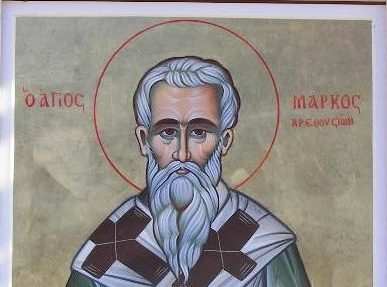Hieromartyr Mark, Bishop of Arethusa, suffered for his faith in Christ under the emperor Julian the Apostate (361-363). By order of the emperor Constantine (May 21), Saint Mark had once destroyed a pagan temple and built a Christian church.
When Julian came to the throne, he persecuted Christians and tried to restore paganism. Some citizens of Arethusa renounced Christianity and became pagans. Then Saint Mark’s enemies decided to take revenge on him. The old bishop hid himself from the persecutors at first, but then gave himself up when he learned that the pagans had tortured many people in their search for him.
The holy Elder was led through the city and given over to torture. They tore out his hair, slashed his body, dragged him along the street, dumped him in a swamp, tied him up, and cut him with knives.
The pagans demanded that the holy bishop pay them a large sum of money to rebuild the pagan temple, and he refused to do so. The persecutors invented several new torments: they squeezed the Elder in a foot-press, and they cut off his ears with linen cords. Finally, they smeared the holy martyr’s body with honey and grease, then hung him up in a basket in the hot mid-day sun to be eaten by bees, wasps, and hornets. Saint Mark did not seem to notice the pain, and this irritated the tormentor all the more.
The pagans kept lowering the price he had to pay for their temple, but Saint Mark refused to give them a single coin. Admiring him for his courage and endurance, the pagans stopped asking him for money and set him free. Many of them returned to Christ after hearing his talks.
Saint Gregory the Theologian (January 25) describes the sufferings of Saint Mark in his First Oration against Julian. Theodoritus of Cyrrhus also mentions him in his Church History (Book 3, Ch. 6)
Saint Mark was Bishop of Arethusa in Syria. In the days of Saint Constantine the Great, Saint Mark, moved with divine zeal, destroyed a temple of the idols and raised up a church in its stead. When Julian the Apostate reigned, in 361, as the pagans were now able to avenge the destruction of their temple, Saint Mark, giving way to wrath, hid himself; but when he saw that others were being taken on his account, he gave himself up. Having no regard to his old age, they stripped him and beat his whole body, cast him into filthy sewers, and pulling him out, had children prick him with their iron writing-pens. Then they put him into a basket, smeared him with honey and a kind of relish of pickled fish, and hung him up under the burning sun to be devoured by bees and wasps. But because he bore this so nobly, his enemies repented, and unloosed him.
We are told about Mark’s suffering by St. Gregory the Theologian and by Blessed Theodoretus. According to these reports, during Emperor Constantine’s reign, Mark destroyed a pagan temple and converted many to the Christian Faith. When Julian ascended the throne and shortly thereafter apostatized from the Faith of Christ, some citizens of Arethusa also denied Christ and reverted to paganism. Then they rose up against Mark because he had destroyed their temple, seeking that he either rebuild the temple or pay a large sum of money. Since the aged Mark refused to do either of the two, he was flogged, mocked and dragged through the streets. After that they severed his ears with a fine but strong thread.
They then stripped him, smeared him with honey, and left him tied to a tree in the heat of summer to be bitten by wasps, mosquitoes, and hornets. The martyr of Christ endured all without complaint. Mark was very old, but his countenance shone like an angel. The pagans reduced the price for their temple even more and finally sought from Mark an insignificant sum. This he could have easily given, but he refused to give even one coin for this purpose. His patience made an enormous impression on the citizens, gaining him their admiration and pity. They then lowered the cost of the temple to practically nothing, in order to allow him to live. Finally they permitted him to go free, and one by one they all received instruction from him and returned to the Christian Faith. At the same time, in the city of Heliopolis at the foot of Mount Lebanon, the deacon Cyril suffered for a similar act. During the time when Christianity enjoyed freedom, Cyril destroyed some idols, and was later brutally tortured under Julian the Apostate.
So embittered were the pagans against him that, when they killed him, they ripped him open with their teeth and tore out his entrails. The same day on which St. Cyril suffered, many others also suffered. The spiteful pagans carved their bodies into pieces, mixed them with barley and fed them to the swine. Punishment reached them swiftly: all of their teeth fell out and an unbearable stench came forth from their mouths.















